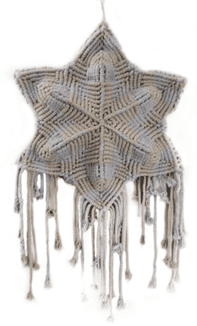Macramé is an art form that consists of tying together different cords into special macramé knots to produce things such as art and fashionable accessories. This very old textile craft has seen a rise in popularity in recent years, with macramé homeware, such as plant pot holders, appearing in homes up and down the country and macramé fashion accessories making more frequent appearances on the high street.

Historians believe that macramé dates back a thousand years, with Arab weavers known to have used decorative macramé knots as a way of tying the ends of textiles such as rugs and clothing.
In addition to being a beautiful crafting art form, macramé has partly stood the test of time because it has well-being benefits. It is a fantastic way to unwind and look after your mental health; what’s more, working with your hands can improve dexterity and support healthy cognitive function.
Which tools do you need to macramé?
Macramé is an easy craft to begin, as you don’t need many tools; in fact, you can even get by with just your hands and cords! Beginners to macramé could benefit from a macrame kit. Providers of kits, such as the Wool Couture macrame kits, also provide instructions to make your beautiful macramé item, taking the hard work out of choosing the right cords.
To make things even easier, you could consider an ‘S’ hook on which to hang your item while you work on it – a macrame kit may include this. You may also find it helpful to have a pair of scissors to hand and a measuring tape to ensure accuracy

Cords
If you are a beginner, you may notice that there are different kinds of macramé cords available depending on the kind of item you want to make: 3-ply, single-twist, and braided. They all have different aesthetics, so it is worth considering which would best suit your project. 3-ply cords are the thickest and starchy, single-twist cords are thinner but fringe well, and braided cords are well structured but can’t be fringed.